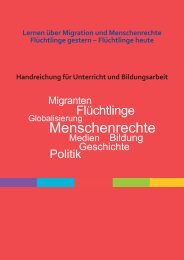IMMIGRATION IN ITALY By Laura Zanfrini* 1. From a source to a ...
IMMIGRATION IN ITALY By Laura Zanfrini* 1. From a source to a ...
IMMIGRATION IN ITALY By Laura Zanfrini* 1. From a source to a ...
- No tags were found...
Create successful ePaper yourself
Turn your PDF publications into a flip-book with our unique Google optimized e-Paper software.
migration industry. Irregular migration <strong>to</strong> Italy represents only a piece of a larger mosaic – such asthe phenomenon of persons’ mobility – which, as everybody knows, has been assuming a planetarycharacter and extent, with compositions and directions that have became increasingly unrelated <strong>to</strong>migration policies. Furthermore, Italy’s configuration and geographical position make it a nervecentre for illegal migration from the Mediterranean and Balkan areas, even though merely in transit<strong>to</strong> other European countries.In the particular case of migration from east European countries – from which the largestflows have originated, especially during the 2000s, – there are many incentive fac<strong>to</strong>rs, but migrationpressure has been driven by the deep changes in these societies along with the passage <strong>to</strong> marketeconomy. These fac<strong>to</strong>rs also depend on economic integration with EU member countries, that hasalready become tangible in several ways: through a process of production unit relocation carried outby several Italian enterprises; through geographical closeness and the ability <strong>to</strong> relatively easilyobtain entry visas; through the attractive power exerted by ethnic networks, which are not yet in theposition <strong>to</strong> organise their co-nationals’ legal immigration on a large scale, but at the same time arestill tempted <strong>to</strong> make a profit from the great amount of emigration candidates; and in the perception– especially among the female component – of a relative abundance of informal job opportunities insupporting Italian families.On the other hand, ethnic networks play a role that goes far beyond the migration flows fromeastern countries. An analysis of the results of the different regularisation provisions seems <strong>to</strong>confirm that in most cases illegal flows are generated by the same reasons that drive regularmigrations and not because some national groups are particularly inclined <strong>to</strong> avoid ordinary entryprocedures. Contiguity with the industry of illegal immigration and human trafficking forexploitation, calling systems on a family and community basis, and mechanisms of emulatingemigrated co-nationals are some of the fac<strong>to</strong>rs that contribute <strong>to</strong> make ethnic networks a strategicelement in providing migration flows with a self-propulsive dynamics. The 2002 big regularisationmade this role particularly visible: we need only think that 11% of regularisation applications weresubmitted by foreign employers, quite often belonging <strong>to</strong> the same community of the worker <strong>to</strong> beregularised; the Chinese community alone submitted about 23,000 regularisation applications. Inthe following years, the advent of a sort of “demandist” orthodoxy – according <strong>to</strong> which the mereexistence of an employer, real or fake, willing <strong>to</strong> hire a migrant would determine a right <strong>to</strong> entry or<strong>to</strong> be regularized – has contributed <strong>to</strong> overestimate actual employment opportunities and <strong>to</strong> neglectthe basic element of the self-propelling nature of migrations, that is <strong>to</strong> say, their tendency <strong>to</strong>become, over time, relatively independent both of law constraints, and of integration chances in thehost society. Actually, the “culture of illegality” is deeply rooted in the culture of migration ofmany migrants’ communities living in Italy (and even in the organizational cultures of many privateand public agencies that deal with immigrants), as a consequence of their ample familiarity with theblack market labour [see § 3].In reality, the major attractive fac<strong>to</strong>r for illegal immigration has undoubtedly been theshadow economy spreading and taking root, a phenomenon characterising the whole country, butwhich has some peculiar regional and sec<strong>to</strong>ral features. In absolute values, the northern regions,thanks <strong>to</strong> their abundance of job opportunities, take the great majority of undocumented migrants.Nonetheless, it is in the southern regions that irregularity becomes a sort of “normal” element in aninstitutional development and operational model that we might define as a “widespread illegalitymodel”. In those regions, infringements of labour regulations have structural features showingvarious levels of seriousness and can even lead <strong>to</strong> the establishment of “phan<strong>to</strong>m” enterprises thatfind in illegal immigration a particularly profitable recruitment area.In the particular case of agriculture, immigrants’ concealed labour is included in a system ofmutual benefits involving employers, new immigrants and, for some aspects, local workers whoenjoy public unemployment benefits. This system is encouraged by the high terri<strong>to</strong>rial mobility ofthe immigrant workforce, which during the year moves from one region <strong>to</strong> another (the “seasonalworkers’ circuit”) following the calendar of fruit and vegetable production. Immigrants’ propensity<strong>Laura</strong> Zanfrini, Immigration in Italy, June 30, 2013. 5







